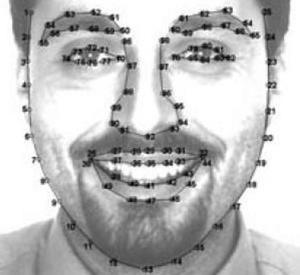Facial-recognition solution offers surveillance new edge
When the new facial-recognition solution finds a match in a database for someone who may be on a watch list, the client may be notified in multiple ways, including text message or e-mail alerts; biographical information such as criminal records are added and the images and made available to the client from any Web browser, including Web-ready mobile phones

Reference points as shown here establish parameters for up to 1 million database comparisons per second // Source: blogspot.com
Picking bad guys out of a crowd in real time is now a bit easier thanks to facial-recognition technology that leverages computing power, high-speed bandwidth, high-definition cameras, and wireless networks.
Face First, a product developed by Airborne Biometrics Group of Camarillo, California, is used by corporations, government agencies, casinos, transportation companies, and other businesses with a need to know when certain individuals are in the area.
“One server can run one facial comparison against 1 million faces in one second,” Airborne Biometrics founder and President Joe Rosenkrantz said. “And our platform is scalable to an unlimited number of servers.”
He said the largest deployment of the Face First system involves scanning a database of 80 million images. Also, the platform can use cameras already installed as part of an existing surveillance system.
“The software looks for variations in gray scales,” Rosenkrantz said. “It uses anchor points, like the width of the nose, distance between the eyes and mouth size. Nearly 10,000 regions on the face are analyzed and facial characteristics are used to make a biometrical template.”
Al Gibes writes in the Las Vegas Review-Journal that when the system finds a match in a database for someone who may be on a watch list, the client may be notified in multiple ways, including text message or e-mail alerts. Biographical information such as criminal records are added and the images and made available to the client from any Web browser, including Web-ready mobile phones.
Rosenkrantz said the platform’s latest addition enables hand-held digital cameras connected to Wi-Fi networks to scan images live. The system uses geographic coordinates to pinpoint the location of the camera that spotted the person in question, which helps track the subject’s movements.
Face First customers can upload new images of people to build databases and improve the chance for a future match, Rosenkrantz said. “People can confirm (the subject) and add a better photo, which makes for a more accurate system. There can be up to 10 pictures of each person. And with 10, there can be 100 percent accuracy. Our niche is live security in the surveillance and counterintelligence environment,” he said. “Facial biometrics is the first thing we chose to take on. Our goal is to layer in other characteristics such as iris and gait recognition and skeletal tracking.”
You can see a video demonstration of the Face First system here.
